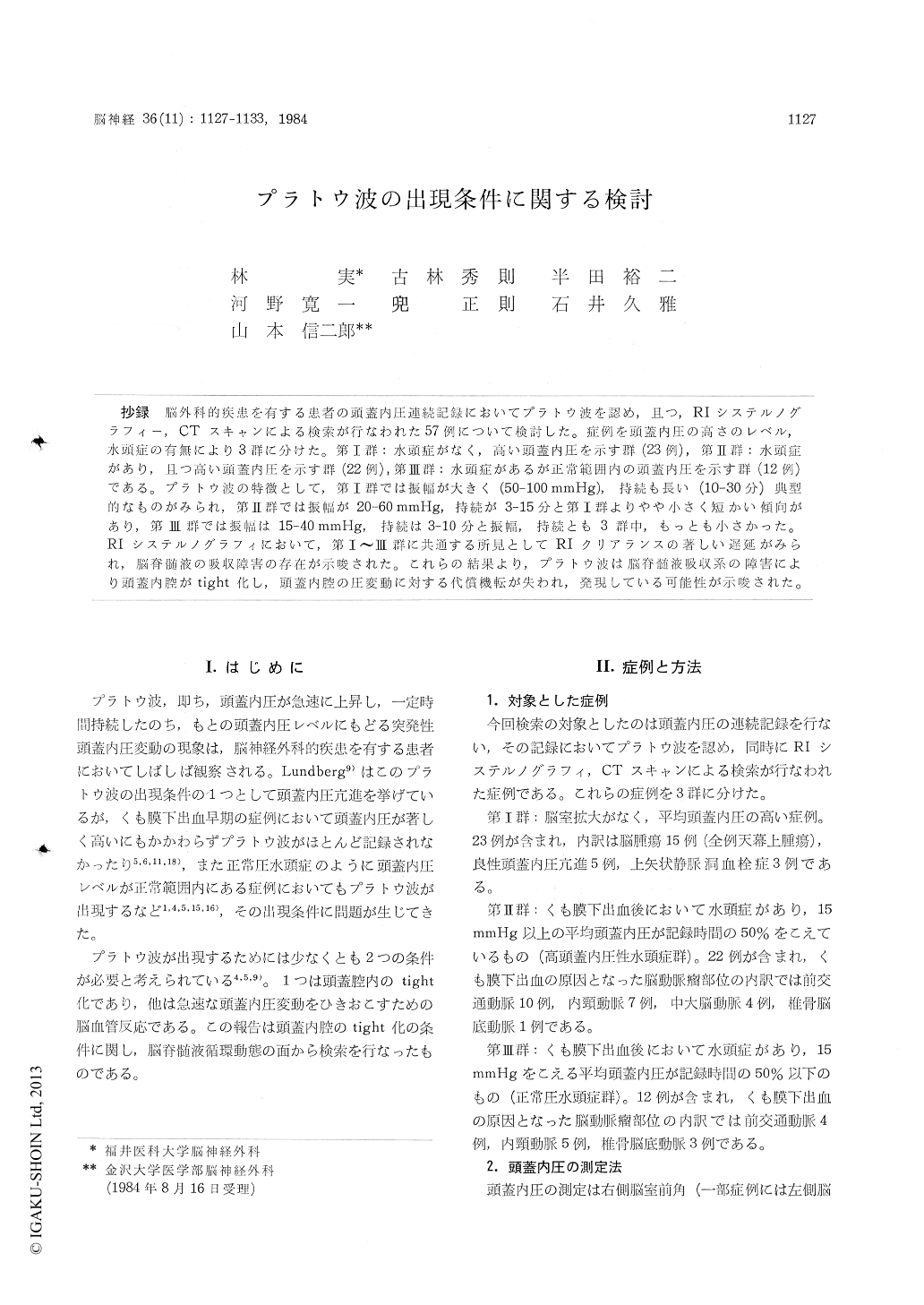Japanese
English
- 有料閲覧
- Abstract 文献概要
- 1ページ目 Look Inside
抄録 脳外科的疾患を有する患者の頭蓋内圧連続記録においてプラトウ波を、認め,且つ,RIシステルノグラフィー,CTスキャンによる検索が行なわれた57例について検討した。症例を頭蓋内圧の高さのレベル,水頭症の有無により3群に分けた。第I群:水頭症がなく,高い頭蓋内圧を示す群(23例),第II群:水頭症があり,且つ高い頭蓋内血圧を示す群(22例),第III群:水頭症があるが正常範囲内の頭蓋内圧を示す群(12例)である。プラトウ波の特徴として,第I群では振幅が大きく(50-100mmHg),持続も長い(10-30分)典型的なものがみられ,第II群では振幅が20-60mmHg,持続が3-15分と第1群よりやや小さく短かい傾向があり,第III群では振幅は15-40mmHg,持続は3-10分と振幅,持続とも3群中,もっとも小さかった。RIシステルノグラフィにおいて,第I〜III群に共通する所見としてRIクリアランスの著しい遅延がみられ,脳脊髄液の吸収障害の存在が示唆された。これらの結果より,プラトウ波は脳脊髄液吸収系の障害により頭蓋内腔がtight化し,頭蓋内腔の圧変動に対する代償機転が失われ,発現している可能性が示唆された。
Isotope cisternography was performed and ven-tricular system size was evaluated on serial com-puterized tomography scans in 57 patients with plateau waves in their continuous intracranial pressure recordings. The patients were assigned to three groups based on the presence or absence of communicating hydrocephalus and their intra-cranial pressure level: the first group comprised 23 patients with high intracranial pressure and without hydrocephalus, resulting from supratento-rial brain tumor, benign intracranial hypertension and superior sagittal sinus thrombosis; the second group included 22 patients with either high intra-cranial pressure or communicating hydrocephalus, resulting from intracranial aneurysmal rupture: and the third group was composed of 12 patients with normal intracranial pressure and communica-ting hydrocephalus, resulting from intracranial aneurysmal rupture.
Plateau waves in the first group patients were characterized as large plateau like formations re-curring at varying intervals, with a height of 50-100 mmHg and a duration of 10 to 30 minutes. Plateau waves in the second group patients had a height of 20 to 60 mmHg and a duration of 3 to 15 minutes. The waves in the second group patients were smaller in amplitude and shorter in duration as compared with the waves in the first group patients. Plateau waves in the third group patients had an amplitude of 15 to 40 mm Hg and a duration of 3 to 10 minutes. They were the smallest in amplitude and the shortest in dura-tion as compared with the plateau waves seen in the first and the second group patients.
The cisternographic pattern in the first group patients showed an abnormally large accumulation of radioactivity over the cerebral convexities in the 24- and 48-hour images, but no blockage of the subarachnoid space. The cisternographic pattern in the second and the third group patients showed complete obstruction of the subarachnoid space over both cerebral convexities and persistent visu-alization of the enlarged ventricles. The headcount rate of isotope at 2, 6, 24, and 48 hours was calculated with correction for room background and decay in each three groups. The head count rate at each interval was then normalized with respect to the peak level of activity and expressed as a percent of this maximum value. The peak activity was not reached until 24 hours in all patients in the first and the third groups and all patients with one exception in the second group patients. The results suggest that, in patients with plateau waves, there was a marked delay in cere-brospinal fluid circulation irrespective of cause. We postulate that the reduction of cerebrospinal fluid absorption may create a critically rigid condition within the cranial cavity. This condition may elicit a secondary rise of intracranial pressure, i. e., plat-eau waves, in response to any change in the intra-cranial dynamics, even if it is of only moderate magnitude.

Copyright © 1984, Igaku-Shoin Ltd. All rights reserved.


